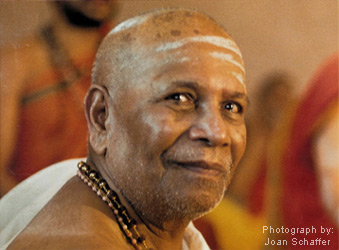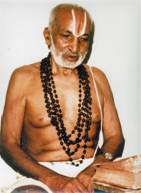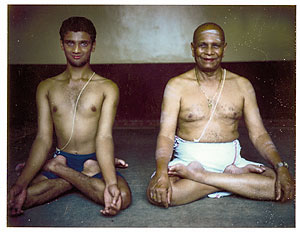
Sri Krishna Pattabhi Jois, lovingly called Guruji by his students, was born in 1915 in the small town of Kowshika, India.
At the age of 12, he met his guru Sri T. Krishnamacharya at a Yoga demonstration at his school. Sri T. Krishnamacharya’s teacher was Rama Mohan Brahmachari who had taught Yoga to Krishnamacharya in a cave in Tibet.
 Sri T. Krishnamacharya
Sri T. Krishnamacharya
Sri Krishna Pattabhi Jois lived a hard life while attending classes at the university. There, he begged for food and biked long distances.
Later on he was offered a scholarship by the Maharaja of Mysore. His scholarship included food and a salary in exchange for teaching Yoga at the university. He taught there until his retirement 36 years later.
Jois married Savitramma and together they had 3 children, Manju, Ramesh, and Saraswati. Saraswati’s son, Sharath, who born in 1971, carries on the teachings and, with his grandfather, is co-director of their school at Mysore.

Guruji & Sharath
In 1964, they had their first Western student. However, it wasn’t until 1972, after more Westerners met Manju at Swami Gitananda’s ashram in Pondicherri, that the teachings of Ashtanga Yoga really began to spread to the West. After this, Guruji traveled to U.S. which helped spread the teachings and practice of Ashtanga Yoga all around the globe. At this moment, Guruji has been teaching without a break since the day he started back in 1927, around 80 years now. He has kept the practice as pure as it was as taught to him by his teacher Sri T. Krishnamacharya.


His favorite phrase is “Don’t think, just practice.”
For more information, visit Guruji’s official web site: http://wwSw.ayri.org/
Ashtanga Yoga Table of Contents
- What is Ashtanga Yoga?
- Pattabhi Jois
- The Eight Limbs
- Ashtanga yoga mantra
- Ujjayi Breath
- Locks / Bhandas
- Drishti / Gaze
- Vinyasa
- Surya Namaskara / Sun Salutation
- Standing poses
- Padangusthasana
- Padahastasana
- Utthita Trikonasana
- Parivritta Trikonasana
- Utthita Parsvakonasana
- Parivritta Parsvakonasana
- Prasarita Padottanasana A
- Prasarita Padottanasana B
- Prasarita Padottanasana C
- Prasarita Padottanasana D
- Parsvottanasana
- Utthita Hasta Padangusthasana A
- Utthita Hasta Padangusthasana B
- Utthita Hasta Padangusthasana C
- Utthita Hasta Padangusthasana D
- Ardha Baddha Padmottanasana
- Utkatasana
- Virabhadrasana A
- Virabhadrasana B
- Primary Series
- Dandasana
- Paschimottanasana A
- Paschimottanasana B
- Paschimottanasana C
- Purvottanasana
- Ardha Baddha Padma Paschimottanasana
- Trianga Mukhaikapada paschimottanasana
- Janu Sirsasana A
- Janu Sirsasana B
- Janu Sirsasana C
- Marichyasana A
- Marichyasana B
- Marichyasana C
- Marichyasana D
- Navasana (5 times)
- Bhujapidasana
- Kurmasana
- Supta Kurmasana
- Garbha Pindasana
- Kukktasana
- Baddha Konasana A
- Baddha Konasana B
- Upavishta Konasana A
- Upavishta Konasana B
- Supta Konasana
- Supta Padangusthasana A
- Supta Padangusthasana B
- Supta Padangusthasana C
- Ubhaya Padangusthasana
- Urdhva Mukha Paschimottanasana
- Setu Bandhasana
- Intermediate Series
- Finishing Series
- Poster To Go
